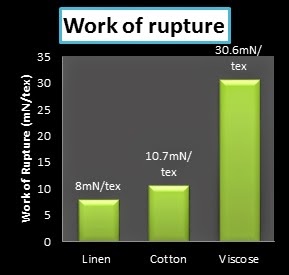Now You Know Why Linen Fiber Shows Poor Performance During Abrasion?
Monday, 4 February 2019
Edit
Why Linen Fiber Shows Poor Performance During Abrasion?
Linen is one of the strongest natural cellulosic fibres obtained from flax plant [Linum usitatissimum]. It’s around 2-3 times stronger than cotton.
The two main fibre properties that determine the abrasion resistance are work of rupture [energy required to break the fibre] & breaking extension [maximum distance the fibre can be stretched before breaking].
Fibre shows good resistance to abrasion,
- When the fibre require high energy to break.
- When the fibre can be stretched to a higher distance before breaking.
| Fibre | Tenacity | Breaking extension | Work of rupture(mN/tex) |
| Linen | 0.54 N/tex | 3.0 % | 8.0 mN/tex |
| Cotton-Upper | 0.32 N/tex | 7.1% | 10.7 mN/tex |
| Viscose | 0.18 N/tex | 27.2% | 30.6 mN/tex |
- The tenacity of linen fibre is 0.54N/tex which is greater than of cotton (0.32N/tex) & viscose (0.18N/tex).
- The breaking extension of linen fibre is 3.0% which is less than of cotton (7.1%) & viscose (27.2%).
- The work of rupture of linen fibre is 8.0mN/tex which is less than of cotton (10.7mN/tex & viscose (30.6mN/tex).
 |
| Tenacity |
 |
| Breaking extension |
 |
| Work of rupture |
From the above comparison it’s clear that the tenacity of linen fibre is more. That is why the tensile properties of linen fibres are more than cotton & Viscose. In case of abrasion due to the poor extension & less work of rupture, linen fibre will be quickly abraded during the abrasion test.
More articles of this writer:
- Factors Affecting the Rubbing Fastness of Textile Materials
- Antimicrobial Finishing of Cotton Fabric with Aloe Barbadensis
- Factors Affecting the Pill Formation on Fabric
- Light Fastness of Textiles: Factors Affecting and Control Measures
- Chemistry Behind Yellowing of Textiles- Causes and Preventive Measures
